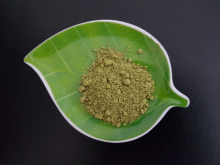
Konichiwa! Let's start with a historical bread from Japan called "Anpan". Anpan is a typical Japanese sweet bread, filled with azuki (red bean) paste. It sounds strange that the creator of this bread was samurai. How come?
In general, Samurai were hired by "Daimyo" (Feudal Lords who suborinate only to Shogun)to guard lands or to be bodyguards of royal family members or the Shogun. The Rule of being Samurai is called "Bushido Shoshinshu" = The way of warrior, Bushi = Samurai. The great honor ritual suicide when the samurai could not protect his master is called "Hara Kiri" or "Seppuku", one who did not follow this rule suffering the supreme shame, then Samurai became "Ronin" (Discrimination act by other Samurai, Daimyo and others by calling Samurai as the wanderer)
Well, when a ronin had no master and no money, either he decided to be "Mercenaries" or " Criminals/thieves". The difference is make a living by teaching swordsmanship or guarding trade caravans or weathy merchants is legal employment as Mercenary and joining organization as thieves or muggers is illegal. Which one would you prefer?
The weapons that samurai carry are traditional Japanese swords called "Katana", a long slender curved single edged blade with long grip to hold with two hands. The other one, a side sword, similar to Katana, but smaller is called "Wakizashi". The ronin carry short swords or staff called "Bo" and "Jo" and/or bow called "Yumi" (Due to lack of money to buy expensive swords or his katana was taken when he did not perform "Hara Kiri").
The hair style of samurai is different from ronin. (Nicely shaved in the middle-more discipline than free style) Which one do you like?
Previously, Samurai can change occupations and masters, later it is forbidden to be employed by another master without permission of the previous master.
According to the story, based on Japanese History that during Meiji period in Japan when the dissolution of samurai occured, many samurai (Medieval Royal military nobility or Military government class in Japanese feudalism) lost their jobs. A samurai named "Yasubei Kimura" saw a baker making breads and it comes to his idea to make his own bread and open a bakery shop in Ginza (a district of Tokyo) named " Kimuraya no Pan" (Kimura is his family name, ya = shop, no = of, Pan = bread). His recipe of Anpan is adding traditional Japanese confections called " Wagashi" in western bread (salty and sour) which was unknown in Japan until that time. The most popular anpan filling in Japan is sweet red bean paste.
Traditional Japanese confections, " Wagashi", are often served in tea ceremony, one of the common type of wagashi is called "mochi" ( the dough is made of sweet glutinous rice flour) with fillings and the other one is called "Manju"(made of flour, rice powder and buckwheat) with anko filling (boiled azuki beans with sugar). Traditionally, "Manju" is using the dough that it is raised with sakadane (liquid yeast).
However, azuki bean is grown in South Asia and Himalayas as well.
The name of Anpan in Japanese comes from
Anko= sweet red bean paste
Pan = bread
Anko is sweet red bean paste that is made of boiled azuki bean with sugar (and/or honey).
Nowadays,the filling could be a mix of azuki bean and sesame (white or black) or only with red bean paste. Sometimes, it is decorated with sesame seeds in the middle of bread instead of pickled sakura. :
The texture of the red bean paste could be rough or fine paste (the rough paste gives more interesting texture than just a plain color of fine paste). However, the fine one is considered to be traditional style and better quality:
The last feudal Japanese military government, the Tokugawa Shogunate (Shogun = Head of military government), somehow knew that the famous samurai "Yamaoka Tesshu" who was elite bodyguard of Tokugawa Yoshinobu and became governor, loved anpan. Tesshu told Tokugawa to bring it when visiting him (a custom to pay a visit), so Tokugawa asked Kimura to make anpan for Tesshu. Kimura presented his anpan with pickled sakura in the middle of bread in 1875. As Yamaoka Tesshu is the founder of swordsmanship school and the hero in the Japanese History.(Negotiator for the peaceful surrender of Edo Castle which led to the official end of the Shogunate in 1868. Because of this, people like him, so his favorite bread, "anpan" turned out to be popular throughout Japan.
Another type of sweets in Japan is called " Yokan" = sweet red bean jelly which is made of azuki bean paste, agar and sugar:
A popular cake in Japan is called "Kasutera" = Castella cake (Portuguese merchants in the 16th brought this style of cake to Japan), sometimes it has a red bean paste or jelly layer:
A cake that contains "Yokan" is an old time Japanese cake, called "Siberia cake" which appeared in an animation film of Hayao Miyazaki, "The Wind Rises" in 2013: (Homemade Siberia Cake, Imitation from the image in the animation)
It consists of 2 layers of sponge cake (like a triangle sandwich)and a layer of sweet red bean jelly (Youkan) which is supposed to depict Siberian Railway in Winter. According to a speculation, the baker who invented this cake was a soldier during the Russo-Japanese war (1904-1905).
After looking closely at it for a while to figure it out how it is resemble Siberian railway, the dark layer is a side of train rail, sponge cake is like snow covering the trail. Have you got the image yet? Not really... try again with this image:
Hmm... Would it looks more convincible when It would be with a poppy seed cake (not a sponge cake)?:
It doen't matter how the story is, the more important is that...
If you pay a visit someone in Japan, do not forget to bring a small item he/she likes as a custom.







